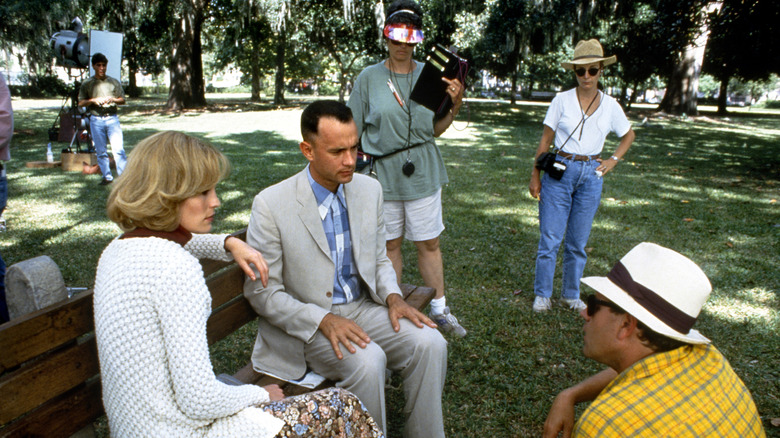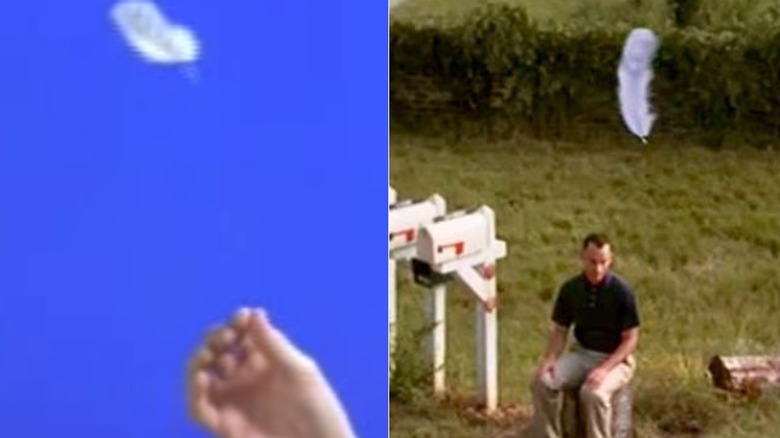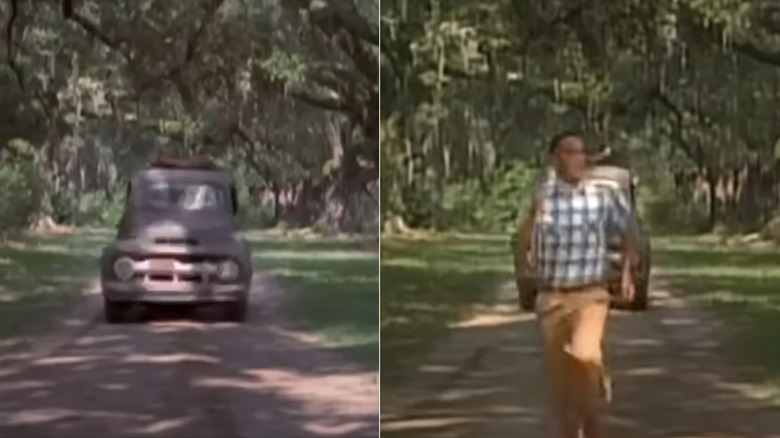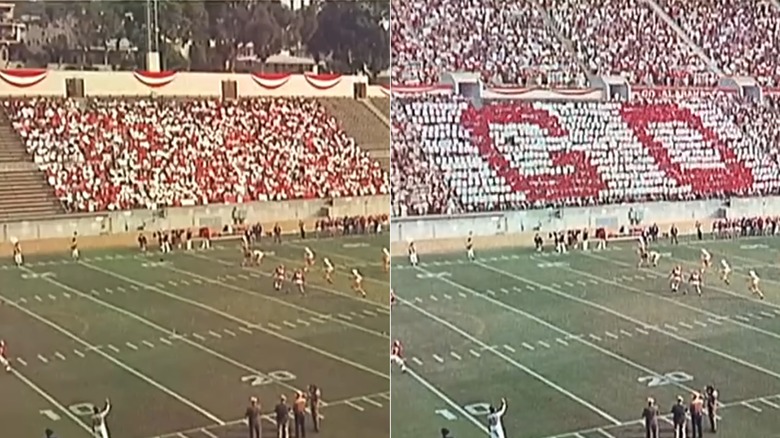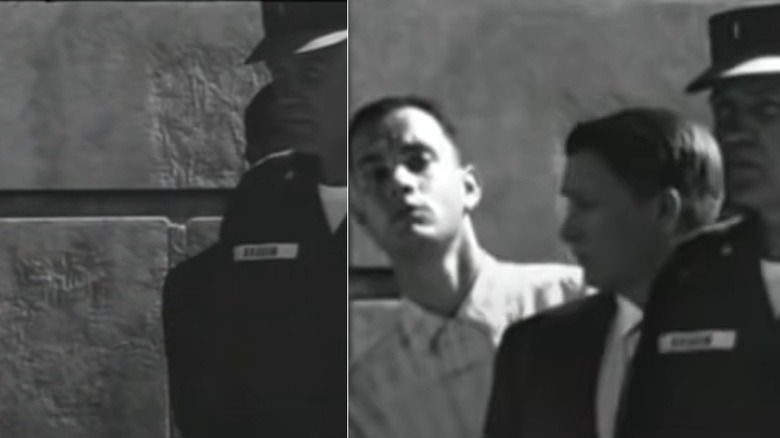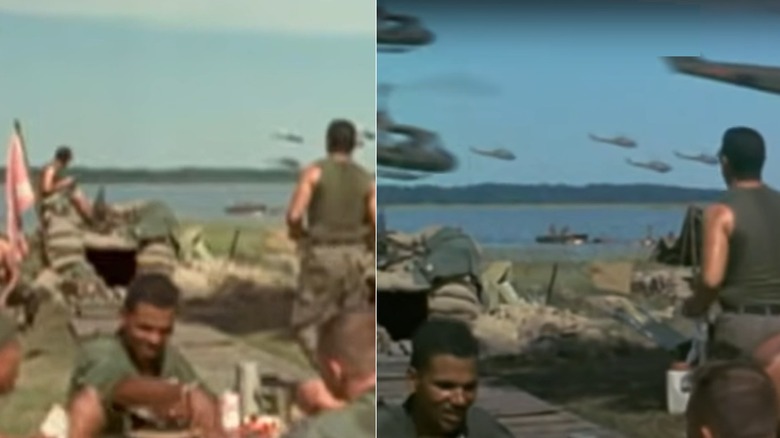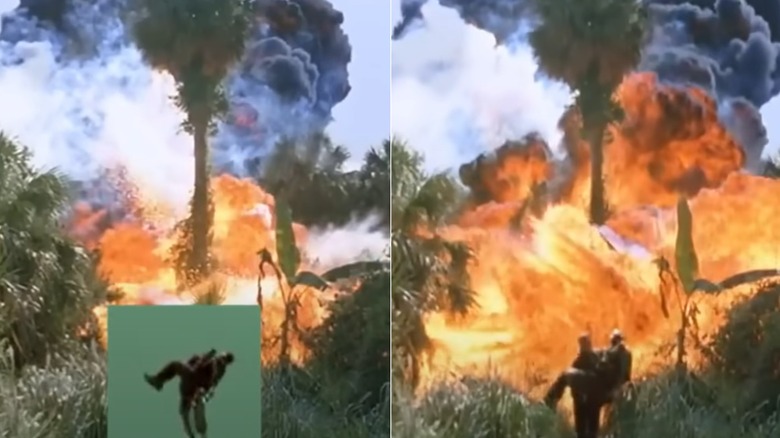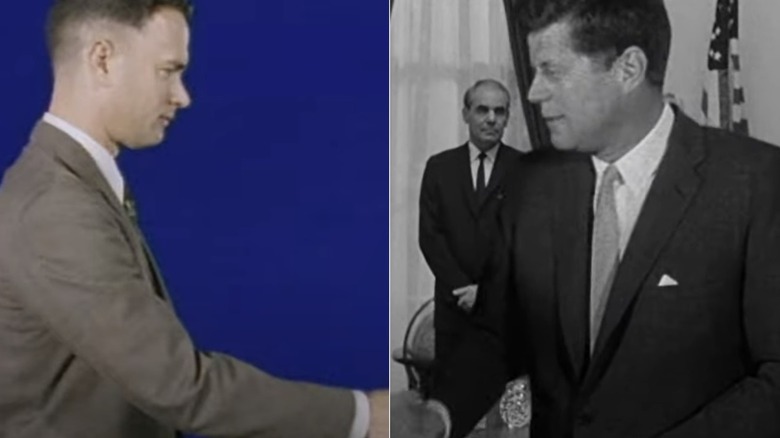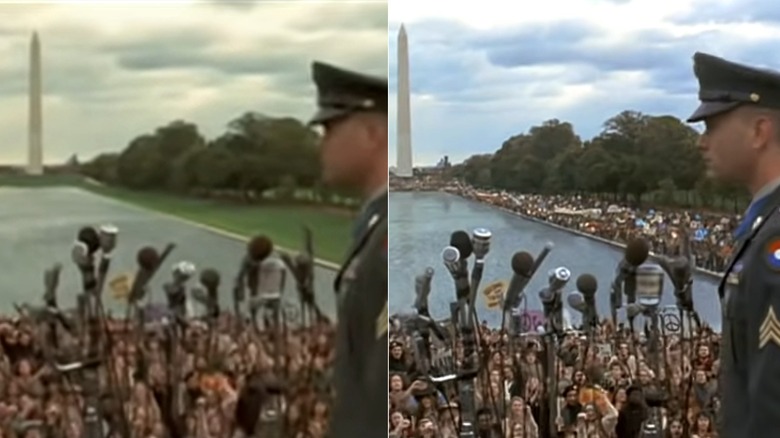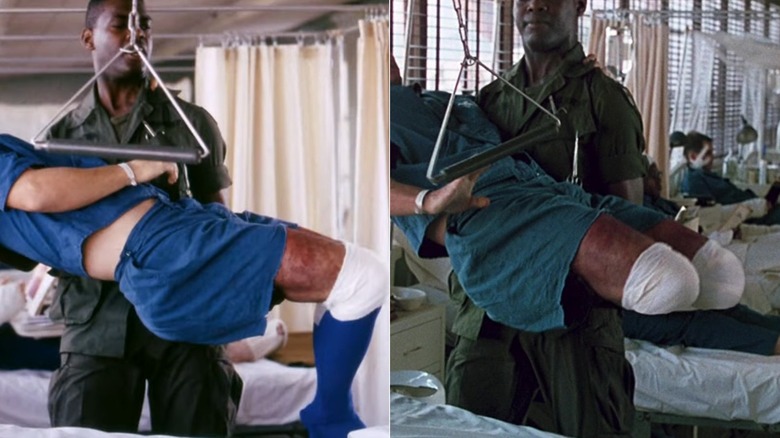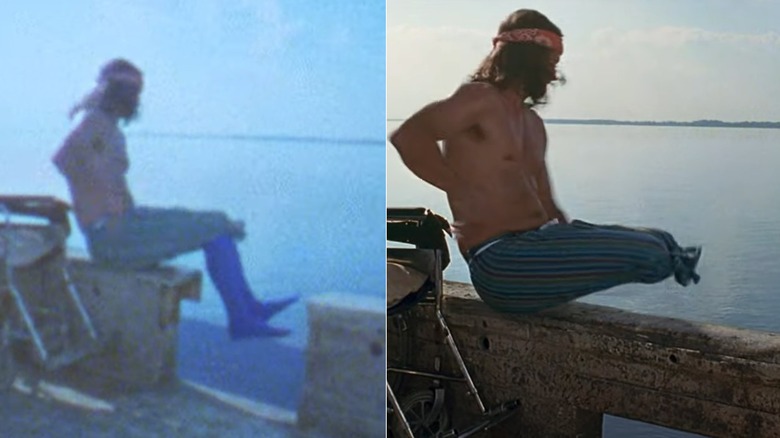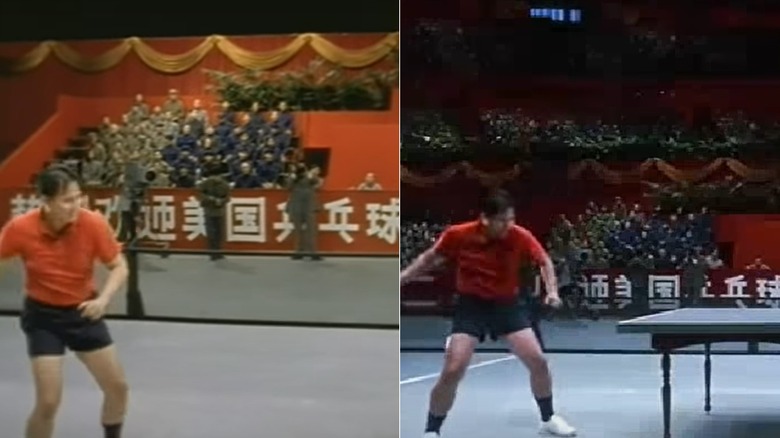What Forrest Gump Looks Like Without Special Effects
These days, we assume that most of the movies we see are filled with computer-created special effects. And that goes beyond the obvious culprits like "Star Wars" or MCU films — there are countless ways that even movies without epic battles between super-powered beings benefit from the many enhancements that digital effects can offer. From making an actor look half a lifetime younger to giving a scene a different tint, it's hard to know for sure if anything that we see on screen anymore is "real" or not.
Of course, this wasn't always the case. When "Forrest Gump" was released in 1994, we had seen computers used for showy, groundbreaking stuff like the Tyrannosaurus rex in "Jurassic Park" to the liquid metal morphing of "Terminator 2: Judgment Day." But few movies outside of the action-adventure and sci-fi genres were doing much with digital effects at that point. So it might come as a surprise to learn just how many computer-assisted shots exist in "Forrest Gump," not just in making it look like the titular character is talking to dead presidents but in more subtle and surprising ways as well.
The feather wasn't really floating on the breeze
One of the most enduring images of "Forrest Gump" is the feather that beautifully dances on the breeze during both the beginning and end credits of the movie. Flying around as composer Alan Silvestri's "Forrest Gump Suite" plays, there are countless theories as to what the feather is meant to represent. The most popular one seems to be the idea that the feather is like Forrest (Tom Hanks) himself, just kind of letting himself float along where ever life takes him. And with that feather, "Forrest Gump" is immediately a special effects movie right from its opening seconds.
Some shots of the feather were accomplished by someone holding a real feather up with a thin wire in front of a blue screen, which was digitally added to the shots in post-production. In other cases — like when the feather comes to land at Forrest's feet at the beginning of the film — the feather was simply drawn in digitally. When Forrest bends over to pick up that feather, it is real — but the real feather was actually on his foot the whole time and was digitally erased in the frames leading up to its landing.
How the bully truck chase scene was pulled off
In some cases, special effects are used for the safety of the people on set. And when a shot requires a pretty clear view of an actor's face, simply swapping them out with a stunt person isn't an easy answer — especially since, in such cases, computers are then needed to put the actor's face on top of the stunt person's body anyway. So if you're going to get computers involved, you might as well just go all the way.
When the truck full of bullies is chasing Forrest down the road toward his house, director Robert Zemeckis wanted it to look dangerous so that Forrest had good reason to be literally running for his life. But actually filming Tom Hanks running from the speeding truck and having it be close enough to cause tension would've meant that a single stumble from Hanks could spell disaster. So the scene where Forrest is running toward the camera with the truck in pursuit behind him was filmed twice — once with just Hanks running toward the camera, and once with just the truck driving toward the camera. The two shots were then layered on top of each other to create the desired effect.
The crowds at the football games were made to look bigger
In the old days, when a movie needed a big crowd scene, the production typically had to actually gather a huge group of extras to fill out the street, stadium, or whatever the setting might have been. Having to wrangle hundreds — if not thousands — of extras, and then making sure they all do what they're supposed to do and keep the necessary energy up for hours of filming can be a huge headache. Not to mention that extras aren't free, so it's also just an expensive proposition.
Computers have made it much easier to simulate large crowds without actually needing large crowds. This was done several times in "Forrest Gump," first in the scenes where he becomes a football player for the University of Alabama. While filming the scenes, only one section of the stadium actually had real live fans in it, with the rest being filled out digitally. In addition, they shot those scenes on a smaller football field in Los Angeles, and then used computers to add an entire upper section of stands and various other elements to mimic a major college sports stadium. Oh, and the audience spelling out words with colored signs? Also just a special effect.
Forrest is inserted into archival news footage
One of the most impressive tricks that "Forrest Gump" pulls off is putting Forrest into real archival footage of various events and having it look natural — at least for the time. Truthfully, some of those shots haven't aged the best, particularly with the advent of high definition and the greater level of scrutiny it allows. But it was convincing for 1994 and certainly played a big role in the movie winning an Oscar for best visual effects.
There is a lot more to consider with these shots than simply filming Tom Hanks in front of a blue screen and inserting him into the clips. A lot of digital tweaking had to be done to make him match the look of the footage, from color to clarity to making sure imperfections in the film that appeared in the blank space of the original footage now appear over top of him. Old news footage was also typically shot by a cameraman holding the camera on his shoulder, which means a lot of jumpy, shaky footage that requires the shots of Hanks to also jump and shake in exactly the same way to match. Computers could probably do all this work much more quickly and easily now, but back when they were working on "Forrest Gump," it was a much more painstaking process — and props to all involved for putting in the (many) hours to pull it off.
Two helicopters are turned into an entire fleet
Robert Zemeckis wanted the war scenes in "Forrest Gump" to look like they came out of an epic war film — not even just during the actual combat but in the peripheral scenes as well. One such shot has the camera panning around the soldiers' camp as the men are eating and relaxing, and an entire fleet of seemingly dozens of helicopters can be seen flying by in the background. But the production couldn't get dozens of helicopters, certainly not flying simultaneously.
In fact, they only got two. So those two helicopters then flew around the set, and multiple people shot those two helicopters from various angles and distances away. This gave the effects team multiple shots of those two helicopters both relatively close up and from a distance, which were then essentially copied and pasted onto the main shot to create the look of many helicopters. Again, today they would've just added all the necessary helicopters via computer — likely even the two original helicopters — but you had to get a little more creative back then as computer effects weren't quite there yet to convincingly fill an entire sky with wholly computer-animated helicopters.
Forrest had a lot of help in his jungle escape with Bubba
No, the napalm-based explosions that set the jungle ablaze as Forrest is carrying Bubba (Mykelti Williamson) to safety weren't computer animated. However, there was still plenty of digital — as well as some practical — trickery going on to help achieve what is easily one of the most visually exciting shots in the entire film. Multiple real explosions were in fact filmed, but some were filmed at different times and at different speeds, which were then put all together for the shot that is seen in the final version.
As for Tom Hanks and Bubba actor Williamson, they of course were never in any real danger. When the two men are seen furthest back in the shot, they are actually two stunt people, running in front of a barrier to protect them from the explosions that were occurring. There is a moment where they stumble a bit, and that was used to mask the digital transition between them and Hanks and Williamson, who were filmed at a different time and far away from any real fire. Hanks also couldn't actually carry Williamson so easily and while running, so a crane arm was used to do most of the actual lifting — which was then digitally removed from the shot.
Forrest shakes hands with John F. Kennedy
It's one thing to just have Forrest as a passive observer in the background of an old newsreel. It's an entirely different thing to have him physically interacting with the footage, and with people who had long since passed away before Forrest was even a book character, let alone the lead of an Oscar-winning movie. The first of the three United States presidents that Forrest gets to meet over the course of the film is John F. Kennedy, who not only speaks to Forrest but even shakes his hand to congratulate him as a member of that year's All-American football team.
First, the effects team had to find footage of JFK shaking someone else's hand in the Oval Office. Then, Tom Hanks had to be filmed in front of a blue screen pantomiming a handshake while lining up both his hand and his eye line to markers that are designed to match up with JFK's hand and eyes. Hanks did this multiple times so that the team could have a few different options to choose from that would best match up with the footage of the president. Once they found their winner, they set about doing all the necessary visual adjustments to make Forrest match the rest of the footage, and suddenly an actor in 1994 appears to be shaking the hand of a president that had been dead for 31 years.
Lyndon B. Johnson gives Forrest a medal
Perhaps emboldened by making it seem as though Forrest was shaking hands with John F. Kennedy, the "Forrest Gump" effects team took things even further when it came to his meeting with President Lyndon B. Johnson. Johnson awards Forrest the Medal of Honor for the bravery and heroism he displayed during the Vietnam War, and Johnson actually reaches his hands around Forrest's neck to pin the medal's ribbon himself.
Tom Hanks didn't have to do as much work in this case, needing only to be filmed standing and then looking over his shoulder as if someone is hanging something around him. The tricky part was taking the footage of Johnson pinning a medal on someone else — who then had to be removed from the shot — and layering it with the shot of Hanks, having Johnson's arms actually pass in front of him. While the footage was at least in color this time, there still had to be significant work done to color and light Hanks to make him look natural to the shot.
As for the moment when Johnson walks away laughing after Forrest bends over and shows the president the war wound, an entirely new set was constructed and shot with an actor doing the bodywork for Johnson, with footage of Johnson's head then being overlaid onto the stand-in.
Forrest's Vietnam speech also needed artificial crowd enhancement
When Forrest gives his (silenced) speech about his experience in Vietnam to a massive crowd in front of the Washington Monument, computers once again came to the rescue in filling out the scene with the hundreds of thousands of protestors needed for the shot. But it wasn't just a matter of taking a chunk of the crowd and duplicating them all around the Lincoln Memorial Reflecting Pool — this time, the process was a long and tedious one.
The people directly in front of Forrest were all real and were actually in the shot when he first walks out to the microphones. As for the crowd around the water, that front crowd was first gathered in a square-shaped clump in one spot in the side grass. They were filmed for a bit, and then they moved to the next spot, over and over and over again until the group had covered the entire surrounding grass area. But the camera isn't completely stationary during this scene, so it had to move in precisely the same way as each current square of people was being filmed. In all, the crowd moved over 30 times in order to make it from one end to the other.
Lieutenant Dan's legs were digitally erased
Besides Jenny (Robin Wright), the only other person in "Forrest Gump" who has significant screen time and spends several large chunks of the movie with Forrest is Lieutenant Dan (Gary Sinise). At first, Lt. Dan is Forrest's commanding officer in Vietnam, then the two are side by side in the hospital recovering from their injuries, and finally, Lt. Dan becomes Forrest's shipmate on his shrimping boat. And in all scenes except the ones during the war itself, Lt. Dan is missing both of his legs from the knee down.
With Sinise himself having two full legs, a lot had to be done to make it seem as though the lower half of his legs were gone across his many scenes after the war. Any time he was mostly stationary, this was a fairly easy fix. For instance, if he was sitting on a bed, there was a hole cut in it where the rest of his legs could be hidden. In other shots, like when he's in his wheelchair, his legs are simply covered with a blanket. But there are also moments where that isn't possible, and that's where the good ol' blue screen comes in. For example, when he is lifted out of his hospital bed, Sinise is wearing blue leg coverings below his knee bandages, which were then removed from the final shot.
A chunk of his boat was digitally removed as well
Those blue leg coverings make a return for several other Lt. Dan scenes, including any shot where simply hiding Gary Sinise's legs behind, inside, or underneath something isn't possible. In one of the character's biggest moments, he is sitting on the side of the shrimp boat, swings his legs over, and then jumps into the water — much to Forrest's horror. With a full view of Lt. Dan's legs and his pants being tied at the knee, there would've been no way to hide Sinise's legs other than to use blue screen trickery.
If Sinise had swung both of his full legs over the top of the boat, the rest of his body would've strained to the weight and awkwardness of the motion and it wouldn't have matched the scene. So a piece was cut out of that part of the boat so that Sinise could pivot in place and let his legs pass through the gap. Then, in addition to his blue-stockinged lower legs being removed from the shot, the portion of the boat that had been cut out was digitally drawn back in to complete the effect — leaving a small area near the bottom so you could still see Lt. Dan pass by on his way down to the water.
There were hardly any physical ping-pong balls in the movie
Spoiler alert: Tom Hanks isn't actually a world-champion ping-pong player who is able to play the game at the speed of Olympic athletes. But Forrest needed to be, and he got a lot of digital assistance to make it appear as such. Almost every ping-pong ball you see in "Forrest Gump" was added by computers after the fact, with Hanks and his opponents just pretending to hit an invisible ball.
In order to mimic the actual flow of a ping-pong game and to tell the actors exactly when to swing their paddles, a metronome played during filming that told them when to swing and to keep them on a steady rhythm. Simply pretending to play proved surprisingly difficult for Valentine (credited as Valentino), the Chinese ping-pong champion who played Forrest's opponent — but he eventually got the hang of it.
It wasn't just the ping-pong ball that was aided by VFX, either — the stadium where Forrest played the championship game in China was just a small set with a small crowd, once again made artificially larger and fuller with computers.
